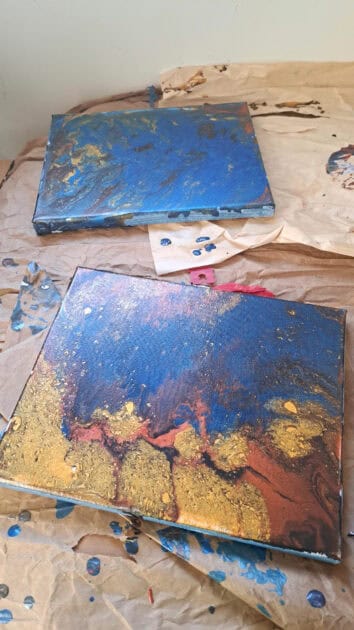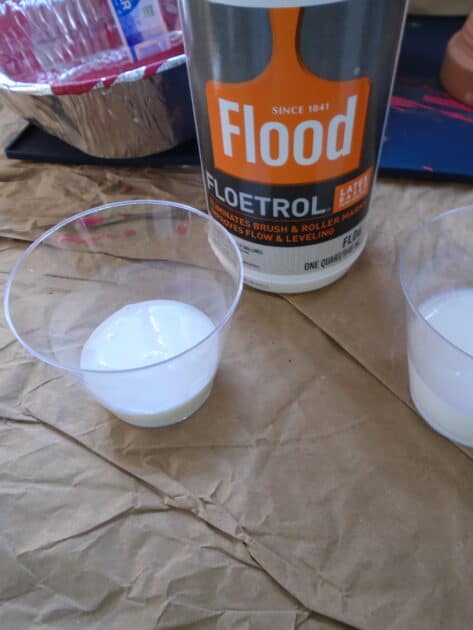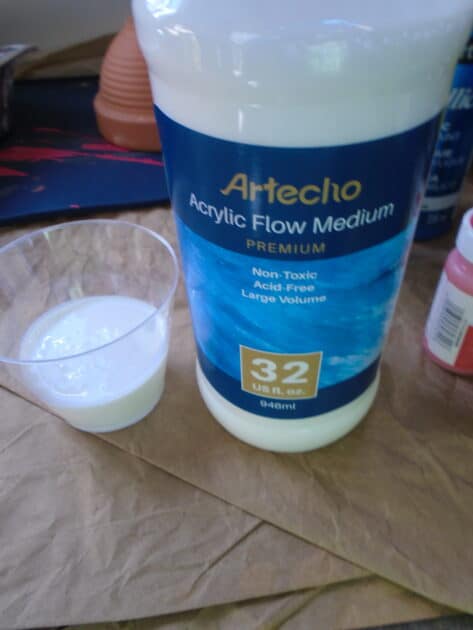This post may contain affiliate links. If a product or service is purchased using a link(s) in the post below a small commission may be earned.
Last updated on July 5th, 2024 at 11:49 am
When you are new to paint pouring you may not always understand the paint to pouring medium measurements. All brands have their own measurement terms. You should always read the direction of your paint pouring medium.
Also, some paints may be a bit of a thicker body so you may need to add water as well. I’ll get more to that later.
some pouring medium measurements are confusing
Every brand is different. Some pouring medium measurement directions can be confusing to a new user. Some may have a percentage of paint to a percentage of pouring medium. Others may be one part paint to X parts medium (that’s a typical measurement.)
If you are ever confused always do your own searching to see how selected brands use pouring medium ratios.
Not all paint pouring mediums are the same
The consistency of your pouring medium varies by brand. some are a bit thin while others may be thicker. I’ve seen pouring mediums that are the consistency of milk while others may be thicker-bodied mediums.
I will note that if some paints and mediums are on the thicker side you may need to add some water.
a note about additives
adding water
Some pouring mediums when added to paint may need a bit of water to thin them out a bit. This means you may have to test how much water to add. I would suggest using filtered water or bottled water when available. You can also use distilled water too but that can get a bit expensive.
If you have a thicker or fuller-bodied paint you may need to add water. I found that if you add small amounts at a time you can control the consistency better.
I added a splash of water (a cap full or to maybe a half teaspoon full) to some heavier-bodied paints with Liquitex pouring medium and it worked well.
This was the final result. I didn’t have a lot of paint cells but the paints did flow much better with the water.

There are other additives you can use as well as silicone oil or even rubbing alcohol. I’ve never added rubbing alcohol to my paint pouring mixture but some people use it. I guess it gives your pours a different consistency.
You may have to experiment with your paint pouring mediums and paints to see which amount of water works for you.
Silicone oil
Silicone oil can be added to your paint pouring mixture. I’ve used it on a few paint pouring projects. Personally, I’ve never seen any big difference when I don’t use it. You only need to add two or three drops to your mixture. I’ve seen people share their opinions on the pros and cons of using it.
The basic point of using silicone oil is that it helps bring out the colors’ brightness and can give you some great cell patterns. You may have to use a torch to see the results you need.
I’ve used this brand a few times. Since you only need a few drops the bottle lasts a while.
let’s talk about pouring mediums
I’ve used three pouring mediums so far. They all range in price and consistency. They also range in pouring medium ratios.
Flood Floetrol

Flood Floetrol is one of the most popular paint pouring mediums used. It’s cheap (Under $10 USD) it also can be found in many stores and online.
This one has a pretty simple pouring ratio.
| Flood Floetrol | Paint |
|---|---|
| 1 part | 2 parts |
I’ve never had to add water to Floetrol. You can also adjust your ratios if needed.
A note on floetrol’s consistency: Floretrol can clump up and even bind if not used often. This can be caused by weather changes or just the general age of the product.
You can shake it before using it as well. You may also want to do a few tests with paint to make sure it doesn’t separate or bind when used with the paints you are planning to use.
artecho

this was a brand I bought from Amazon. It’s a different consistency and the measurement rations can be adjusted. I will add that this has the consistency of milk. So depending on the thickness of your paint, you may want to add less than suggested.
According to their Amazon page, they suggest you use one part paint to nine (yes it says nine) parts Artecho pouring medium.
For me I found this to be a bit wasteful. The first time I used this my paint-pouring canvas looked a bit muddy. I also felt it had too much medium in it so I had to add more paint.
I opted to try a traditional take on it. For my second paint pouring canvas, I opted to try the following ratios
| Artecho pouring medium | Paint |
|---|---|
| 3 part | 1 part |
I believe this was the result of the second paint pouring test I did using the mentioned pouring ratio. FYI the date on that picture is wrong for some reason my camera still shows 2021 as the year.

The Artecho paint pouring medium is around $20 USD. Depending on your pouring project this bottle may last you a while.
Liquitex pouring medium
Liquitex is a premium/artistic brand of pouring medium. It isn’t cheap and the measurement ratios are a bit confusing. The bottle uses a percentage formula. Liquitex consistency is similar to watered-down glue. It’s thick and viscous but flows well. Also, don’t shake the bottle you may have a lot of cells if you do.
According to the bottle you use 5 percent paint to 95 percent pouring medium.
If you’re like me and aren’t a math wiz your like what?
So this one I had to figure it out on my own.
I will note that if you use a thicker bodied paint with Liquitex medium you will need to add a bit of water. I added a splash of water when I did my projects. If not some paints don’t pour well. Even with thinner paints, you may need to add a little water. You’ll have to test this out on your own to see how much you’ll need to add.

| Liquitex pouring medium* | Paint |
|---|---|
| 3 part | 1 part |
| *(asterisk note) | add a splash or cap full of water to your pouring mixture for thicker or heavier-bodied paints |

you can also use measurements
If you have a food scale you can also weigh your paints and pouring mediums if you want the most accurate results. I haven’t done this because it seems a bit tedious. But you can use measuring spoons and a scale.
which ratio is right for you?
I can’t say. Everyone’s project sizes and needs are different. I’d say do a few test pours to see which one works for you.
Here are a few items that may interest you.

which product would you use? Do you think the ratios matter?



